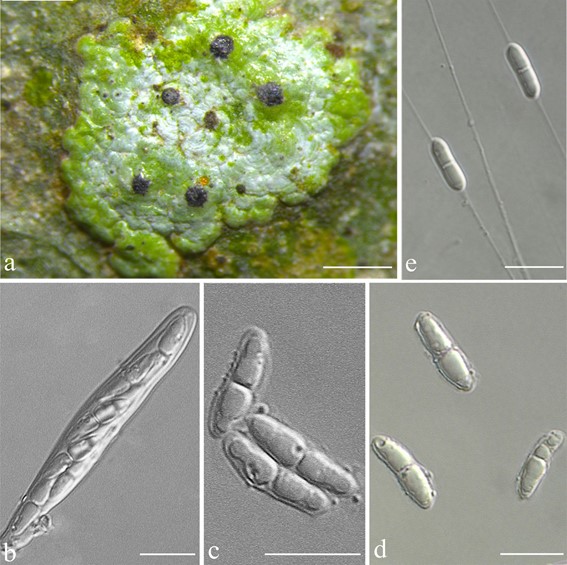Serusiauxiella filifera S.H. Jiang, Lücking & J.C. Wei, sp. nov. Fig. 8
MycoBank number: MB 833566; Index Fungorum number: IF 833566; Facesoffungi number: FoF;
Type: CHINA. Hainan: Dongfang City, Nanlang village E’xian Ling; 19°00′18″ N, 109°04′09″ E, 160 m; on living leaves; 13 December 2014, J.H. Wang & R.D. Liu HN2014362 (HMAS-L0130626).
Diagnosis: Characterized by its applanately hemispherical perithecia that are covered by thallus except for the uppermost portion, and by rather short asci.
Etymology: The epithet refers to the macroconidal appendages becoming long and filiform in squash mounts.
Description: Thallus epiphyllous, subcuticular, 2–8 mm across and 12–20 μm thick, sometimes growing along the nerves, margins, and scars of leaves, circular, with entire to crenulate or lobulate margins, bright green, but often becoming whitish in the center, different color shades often arranged in concentric zones, rather easily separated from leaf. Photobiont a species of Trentepohlia, cells angular- rounded, 5–10 × 3–6 μm. Perithecia usually present and abundant, immersed-erumpent, applanately hemispherical, 105–120 μm high; excipulum prosoplectenchymatous, 12–20 μm thick, colorless to blackish brown; involucrellum developed only in upper part, carbonaceous, laterally fusing with thallus, 30–45 μm thick; paraphyses unbranched or sparingly branched. Asci oblong, 37–53 × 10–12 μm. Ascospores biseriate or irregularly arranged, 8 per ascus, fusiform-ellipsoid, with more or less rounded ends, 1-septate, usually with 1–2 guttules in each cell when fresh and thus appearing 3-septate, especially in 10% KOH, slightly constricted at the septum, usually with the distal cell some- what enlarged, not breaking into pieces, surrounded by a thin mucilaginous sheath, 10–15 × 2.5–5 μm. Pycnidia producing macroconidia 0.05–0.15 mm, immersed-erumpent, wart-shaped, black. Macroconidia bacillar, 1-septate, 12.5–15 × 2–3.5 μm, with gelatinous appendage at both ends, 13–25 μm long but in squash mounts quickly growing to 70 μm or more. Pycnidia producing microconidia not seen.
Chemistry: No substances detected by TLC.
Ecology and distribution: The new species grows on leaves in wet tropical forest in southern China. At present, it is known only from the type locality, but documented by numerous specimens.
Notes: This new species externally resembles Strigula microspora (Lücking 2008), from which differs chiefly by its rather applanate perithecia, short asci and biseriate ascospores. Strigula caerulensis P.M. McCarthy and S. macaronesica Sérus. also bear some resemblance, but in S. caerulensis the thallus is supracuticular, dull, and perithecia are rounded to subacute (McCarthy 2009b). Strigula macaronesica differs in its long linear thallus and larger ascospores (Sérusiaux 1997).

Fig. 8 Serusiauxiella filifera sp. nov. (holotype, HMAS-L0130626) a Thallus, b Asci, c, d Ascospores, e Macroconidia with extremely long appendages. Scale bars: a = 600 μm, b–e = 10 μm
